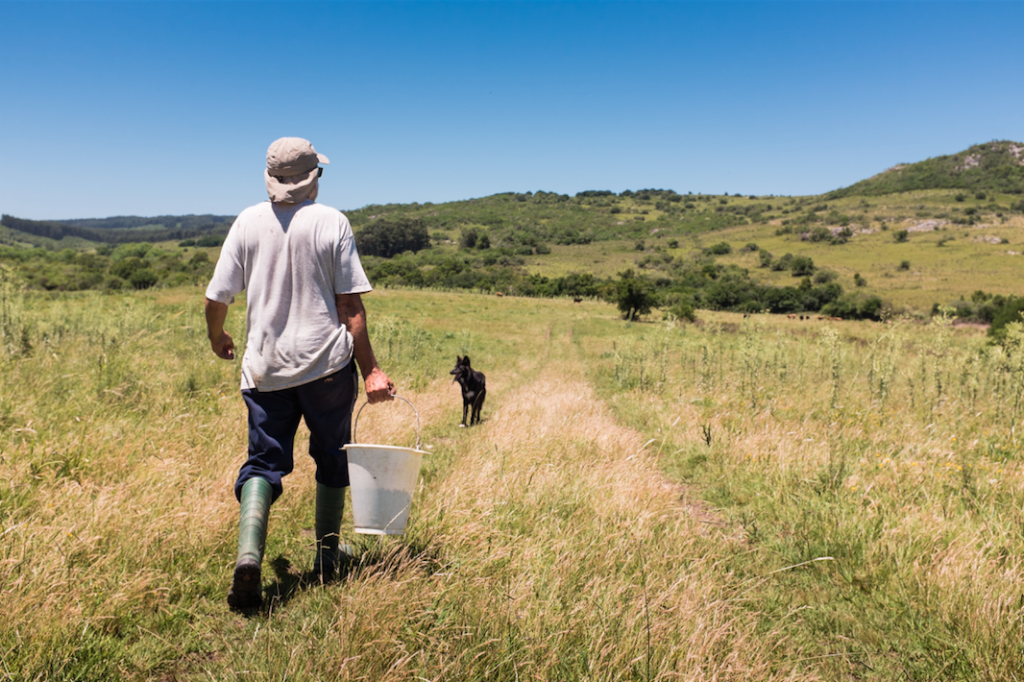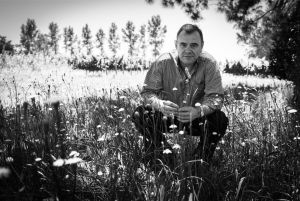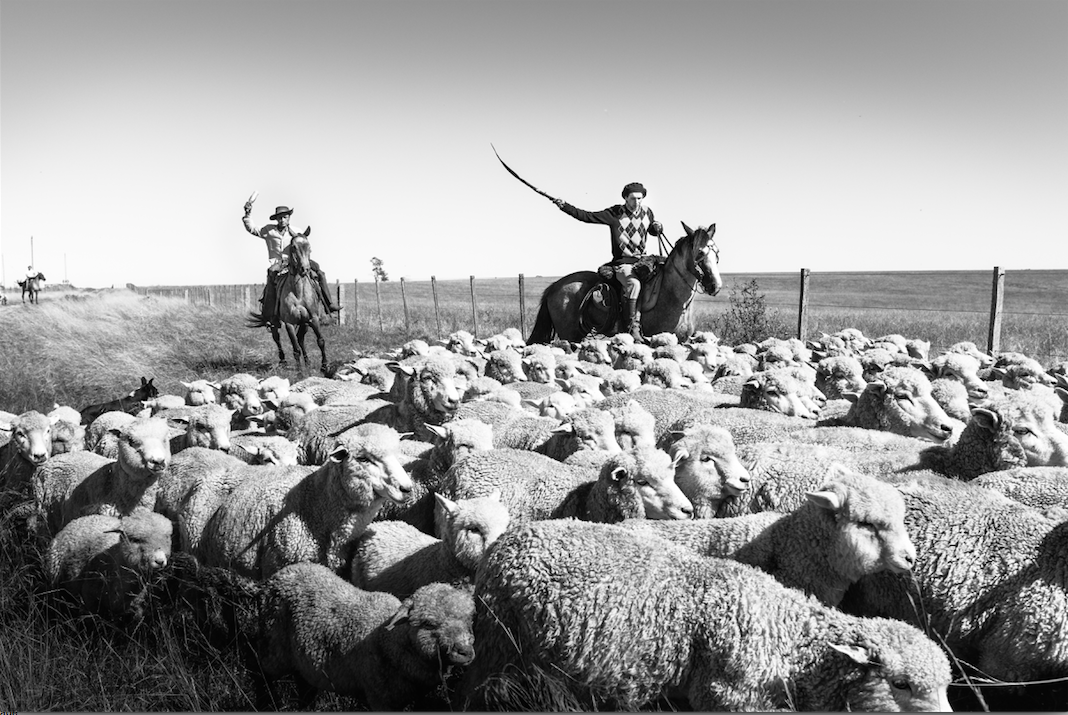Seeds of Hope: IRI in Uruguay
This story was written by David Craig and originally appeared in the Spring 2015 issue of Columbia Magazine. Photography and additional reporting by Francesco Fiondella.
As climate change creates agricultural instability around the world, Columbia scientists are testing a seasonal forecasting system in Uruguay to give farmers a fighting chance.

Daniel Lalinde on his farm in the Maldonado Department of southeastern Uruguay. Francesco Fiondella
Daniel Lalinde doesn’t need a climate scientist to tell him that the sun shines hotter and brighter than it used to. At El Coraje, his farm in Uruguay’s Garzón hills, he can feel the difference on his face and arms, which burn more easily now. To protect himself, he no longer works his fields between eleven in the morning and four in the afternoon. His cattle are suffering, too: they cling to the edges of their pasture, seeking shelter beneath the tree canopy.
“The summer is very hot, and the winter isn’t as cold. It isn’t even winter,” says Lalinde, who works alongside his wife, Margarita, and a few part-time farm hands, growing vegetables and raising cattle for beef. “We see extremes in rainfall, too. Either there’s too much rain or not enough. There is no middle ground.”
The Lalindes dug a small reservoir on their land so that the livestock have enough to drink during dry spells. They diligently follow the weather reports on local television, looking for hints about how much water they ought to preserve on any given day. The daily reports are useful, but the Lalindes say that longer-term forecasts would serve them better. If they knew their pastures were likely to wilt in the summer, for instance, they might buy fewer calves in the spring, to ensure that the cattle they do raise get enough grass to eat. Even minor miscalculations can prove costly: packaged feed is expensive and will eat into their profit margin.
Farmers across the globe must grapple with extreme weather fluctuations, but in Uruguay, a country where more than 80 percent of the land is devoted to raising animals and growing crops, these challenges are felt acutely. This is why the Uruguayan government is working with Columbia’s International Research Institute for Climate and Society (IRI) to create one of the most sophisticated agricultural information networks in the world. The country’s new National Agricultural Information System, funded by a $10 million loan from the World Bank, and developed in partnership with scientists at Uruguay’s National Agricultural Research Institute and the Ministry of Livestock, Agriculture, and Fisheries, will help farmers prepare for each new season by generating remarkably precise climate forecasts that predict temperature and rainfall patterns up to three months in advance. The forecasts will be unusual in their geographic specificity, providing different climate scenarios for about forty distinct regions in this country the size of Florida. The climate data will then be translated into terms useful to farmers — for example, by visiting a website and clicking a map to indicate where he lives, a cattle farmer will learn how much rain is likely to fall on his land over the summer, whether it will be spread out evenly over the season or arrive in a few torrential bursts, and how this could affect groundwater levels and the lushness of his fields.
“If the fields are going to dry out, maybe he’ll invest in new irrigation equipment instead of buying lots of new calves,” says Walter Baethgen, a Columbia agronomist and environmental scientist who is overseeing the ten IRI researchers who are working on the project.
And if heavy storms are expected on Uruguay’s western coastal lowlands, where flooding has often caused corn, sorghum, and soybean seedlings to wash away?
“Maybe they’ll wait out the rains before they plant,” Baethgen says. “The idea is to provide farmers with cutting-edge climate data in terms that anybody can understand.”
The new seasonal forecasting service could be transformative for Uruguay, a small democracy of three and a half million people wedged between Brazil and Argentina on the southeast coast of South America. Farm products represent more than two-thirds of Uruguay’s exports, but in recent years the changing climate has led to poor harvests. While the country has staved off widespread hunger, thanks to ample grain reserves and a modern food-distribution system, it has suffered financially. The last major drought, which occurred in 2008 and lasted almost a year, affected not only farmers but also truckers, storage-facility owners, grain-processing-plant employees, dockworkers, shippers, exporters, commodities investors, and financiers.
“A nation whose economy is based upon agriculture will see its fortunes rise and fall on the shift in the winds,” says Baethgen, a native Uruguayan who came to the United States in 1984 to earn a PhD in crop and soil environmental sciences at Virginia Tech. “That’s the way it’s always been.”

Walter Baethgen in Las Brujas, Uruguay, where he has established a field office for Columbia’s International Research Institute for Climate and Society. Francesco Fiondella
Baethgen, sixty, has devoted much of his career to helping South American farmers survive these shifts. He began this work in the early 1990s, when, as a researcher for the International Fertilizer Development Center, an Alabama-based nonprofit, he conducted some of the first studies showing how annual yields of wheat, barley, rice, corn, soybeans, cotton, coffee, and many other crops in South America were likely to be affected by climate change. His research, which employed a novel combination of computer-based climate and crop-simulation models, carried dire warnings: food production on this continent was likely to drop off and to become less consistent from season to season.
“It wasn’t obvious to people at the time that global warming was going to be bad for agriculture in this part of the world,” says Baethgen. “A warmer atmosphere was certainly going to increase precipitation overall, which you’d think would be good for crops. But the science showed that fluctuations in the weather were going to hurt most farmers.”
Baethgen soon published papers describing how farmers could minimize crop losses in extreme weather by adjusting their soil chemistry, planting schedules, and irrigation strategies. He became frustrated, though, at how difficult it was to change behavior. Part of the problem, he found, was that farmers had trouble drawing clear lessons from seasonal climate forecasts. This was understandable because the forecasts available at the time were vague instruments, offering only predictions of whether the average temperature and total rainfall for an entire season would be low, normal, or high. Baethgen also realized that many of his fellow scientists did not effectively communicate their recommendations to farmers: too often they would advise farmers to make certain tilling, planting, or fertilizing decisions based upon a single climate variable. The farmers tended to shrug them off.

Sheepherding in southern Uruguay. Francesco Fiondella
“Farmers make decisions based on all sorts of factors — the weather, obviously, but also market prices, production costs, fertilization requirements, the risk of disease to crops,” he says. “They think about these factors holistically, and often quite intuitively. If you tell a farmer there’s a 40 percent chance of getting more rain than normal, and a 20 percent chance of getting less rain than normal, how is he supposed to use that information? He’s trying to decide whether to plant soybeans or maize. You need to give him information in a way that helps him answer that question.”
In 2004, Baethgen was recruited by Columbia to be part of the IRI, an interdisciplinary unit within Columbia’s Earth Institute whose mission is to help people adapt to climate change, especially in developing countries. The IRI’s forty-member staff includes climate scientists, as well as researchers who, like Baethgen, specialize in making climate data accessible and relevant to people working in agriculture, public health, urban planning, economic development, ecology, and other sectors.
“The IRI is the only place I know of that has made a science of turning raw climate data into actionable knowledge,” says Baethgen. “It’s a place where a Columbia professor can tell a public-health official in Bangladesh if floods are likely to cause cholera epidemics anytime soon. Or, in my case, whether farmers ought to be worried about their cattle going thirsty.”
Since coming to Columbia, Baethgen has contributed to IRI agriculture projects throughout the world. He has worked on efforts to discover which types of corn are most likely to withstand rising temperatures in West Africa, how rice crops will react to new rain patterns in India, and what potato varieties might survive drought conditions in Tanzania. Baethgen’s research in Uruguay, meanwhile, has benefited from the cross-disciplinary contributions of IRI climate modelers, economists, management experts, psychologists, sociologists, ecologists, and financial analysts. His access to the University’s intellectual resources, he says, has enabled him to undertake increasingly ambitious projects in his home country, many of them supporting the National Agricultural Research Institute (known by its Spanish abbreviation, INIA), a research and development agency with close ties to Uruguay’s agriculture ministry. In 2007, for instance, Baethgen helped to organize a collaboration between INIA and IRI scientists to create a system for monitoring soil-moisture levels across Uruguay; electromagnetic images of the soil captured by NASA satellites are now analyzed regularly by Uruguayan scientists to see if drought conditions are imminent. “The country’s agriculture officials appreciate this, because it can validate their request for relief funds if, say, they want to provide emergency credit lines to farmers for purchasing water,” says Baethgen, who in 2010 received the Morosoli de Oro, a prestigious award given to Uruguayan citizens for service to their country. “A lot of trust has been built up between Uruguay and Columbia over the years.”
The relationship deepened last year when INIA allotted the IRI $1.6 million to lead the development of its new seasonal forecasting and information service. Baethgen quickly assembled a group of Columbia scientists with the expertise to build the necessary climate-modeling technologies and to present the results in a way that was useful to farmers. He set up an IRI office in Las Brujas, a small town thirty miles outside of Montevideo, to accommodate the large numbers of Columbia faculty, researchers, and students who would be traveling to Uruguay to work on the project.
“We now have a steady stream of Columbia scientists coming here,” says Baethgen, whose role on the project is to coordinate the collaborations between Uruguayan scientists and their Columbia partners. “Eventually, the new IRI office will be promoting the involvement of Columbians on similar climate-risk-management efforts throughout the Southern Cone region of South America.”
The first Columbians to work on the project were climate scientists led by Paula Gonzalez, an associate research scientist at IRI who specializes in operating computer models that generate seasonal forecasts. These computer models, Gonzalez explains, are similar to those used to create the daily weather forecasts delivered by TV meteorologists. The main difference is that whereas meteorological forecasts are based solely on analyses of the planet’s current atmospheric conditions, seasonal forecasts also incorporate predictions of how sea-surface temperatures are likely to change over the next three to six months. Scientists have learned to anticipate sea-surface temperatures this far in advance, Gonzalez says, by observing the atmospheric cycles known as El Niño and La Niña, which cause predictable changes in water temperature across the eastern tropical Pacific and, in turn, affect weather patterns around the earth.
According to Gonzalez, the computer models that she and her colleagues are developing for Uruguay’s National Agricultural Information System (SNIA) will produce seasonal forecasts that will in some ways be the most sophisticated in South America. In addition to being geographically precise — the Lalindes, for instance, will get different forecasts than will cattle farmers in neighboring districts — the forecasts will describe the future climatic conditions of each region in unusual detail. Rather than simply predicting average temperature or rainfall accumulation for the next season, for example, they will indicate whether intense heat waves or dry spells may be coming.
“This is what climate scientists call ‘weather-within-climate’ predictions,” says Gonzalez, whose team is also training Uruguayan technicians to operate the models. “We can’t possibly say what the weather will look like on any given day, or any given week, months in advance. But we can get an idea of how wet and dry periods are likely to be distributed, based on the patterns of high- and low-pressure systems that are appearing in our simulations.”
A separate group of IRI researchers led by Catherine Vaughan ’09GSAS, an environmental scientist who studies how people make decisions related to climate change, was recruited by Baethgen to develop the Web portal that farmers will use to access SNIA’s climate forecasts. This portal is the most distinct aspect of SNIA’s service, according to Vaughan; never before, she says, have seasonal climate forecasts been made available to people in a form as user-friendly and practical. In addition to telling a farmer what climatic conditions to expect next season, the portal will also tell him how these conditions could affect the yields of his crops. It will do this, Vaughan says, by analyzing the farmer’s climate forecast against a database containing huge amounts of information on past harvests.
“If he tells the website where he lives, what type of soil is on his land, how he irrigates, and what fertilizers he uses, he’s going to get individualized feedback about what his crop yield could look like,” says Vaughan, who is working with Uruguayan social scientists and agriculture experts in creating the portal. “Maybe he’ll see what the predicted outcome is for corn, and then get a similar analysis for soybeans so he can compare the two.”
To Baethgen, a lot is riding on the project’s success. He believes that if large numbers of Uruguayan farmers use the forecasting service — and if this has a demonstrable impact on their productivity and livelihoods — other countries might implement similar forecasting systems. The approach could be effective, he says, anywhere people have Internet access and a well-functioning agriculture ministry.
“The reason you don’t see systems like this operating in the US or Europe is because wealthy countries have government-subsidized insurance programs that bail out farmers whenever there is a bad harvest,” says Baethgen. “As a result, there’s not much demand within the agricultural industry for something like this. Developing countries, on the other hand, can’t afford expensive farm subsidies. But they can afford to give their farmers the information they need to pursue efficient, climate-smart agriculture.”






You must be logged in to post a comment.